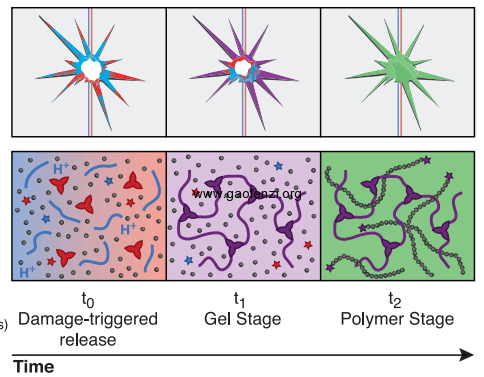在前文中介绍过两篇自修复材料文献,但是目前所谓的自修复材料并不具备真正恢复原状的功能,只能修复微小的裂缝,科研人员追求的就是让材料无限接近原始状态或者性能超过初始状态,实现各种大小缺陷的修复,真正意义上实现自修复。(两篇自修复文章)
最近science报道了美国科学家最新开发的一种自修复(self-healing)新材料研究成果,这种模拟人造血管修复的材料通过两步法可以修复超过3cm大小的空洞(如下图),第一阶段是形成凝胶,第二阶段是单体聚合形成新的聚合物。通过再生凝胶和聚合物填补裂痕和空洞,使材料变得更加坚固,据悉,这种方法未来可用于难以维修的航空航天领域。

详情请阅读参考文献:
Science 9 May 2014:
Vol. 344 no. 6184 pp. 620-623
DOI: 10.1126/science.1251135
标题:Restoration of Large Damage Volumes in Polymers
作者:S. R. White1等
摘要:
The regenerative power of tissues and organs in biology has no analog in synthetic materials. Although self-healing of microscopic defects has been demonstrated, the regrowth of material lost through catastrophic damage requires a regenerative-like approach. We demonstrate a vascular synthetic system that restores mechanical performance in response to large-scale damage. Gap-filling scaffolds are created through a two-stage polymer chemistry that initially forms a shape-conforming dynamic gel but later polymerizes to a solid structural polymer with robust mechanical properties. Through the control of reaction kinetics and vascular delivery rate, we filled impacted regions that exceed 35 mm in diameter within 20 min and restored mechanical function within 3 hours. After restoration of impact damage, 62% of the total absorbed energy was recovered in comparison with that in initial impact tests.
Editor’s summary:
Self-Healing Larger Wounds
By loading a polymer with pockets of monomer, it is possible to heal small cracks in a sample through the polymerization of the monomer following the formation of a crack. However, large holes are much harder to repair. White et al. (p. 620; see the Perspective by Zhao and Arruda) developed a vascular-like repair system involving a dual-stage strategy to self-heal epoxy thermosets. After injecting a damaged site with precursors, a gel with reversible cross-links rapidly formed, so the material stayed in place that then solidified further upon cross-linking. The approach successfully patched holes larger than 3 centimeters in diameter.